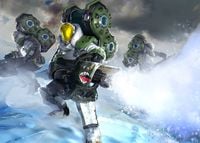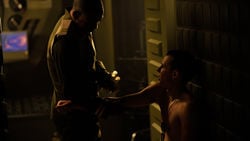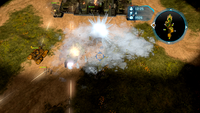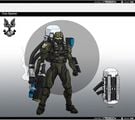Cryonics
From Halopedia, the Halo wiki
| There is more information available on this subject at Cryonics on the English Wikipedia. |

Cryonics is the science of preserving a human or other organism in stasis for extended periods of time. It is often mistaken for cryogenics, which is merely the study of cold on materials.
The goal of cryonics is to allow an individual to "sleep" through long intervals of time, without suffering the effects of biological aging, and then allow them to wake up again without ill effects. Cryonic suspension can reduce the human body's metabolism to near zero, thus preventing aging and eliminating the body's need for oxygen, food, and warmth. The UNSC uses cryonic storage pods in most warships, maintaining only skeleton crews until the vessel reaches their target zone.[1] The majority of personnel are placed in cryonic suspension for any voyage over 120 hours to prevent aging during the journey and to conserve onboard resources.[2]
The Covenant have not been observed using comparable technology; their starships' dramatically higher velocities in slipspace would render the use of stasis unnecessary in most cases. The Forerunners used a system similar in practice, but using a timelocked slipspace field to store the personnel within the pod instead of freezing them.[3]
Procedure[edit]
Put-down cycle[edit]
- "You breathe in, the chill spreads through your chest. And the surfactant, you can feel it filling your lungs. By the time you realize your eyes are closed, they are already too heavy to open."
- — Dimah Tchakova
Individuals enter cryonic suspension without any clothing. This is because clothing tends to bond to the skin at extremely low temperatures.[2] Individuals who disregard this and enter cryo-sleep with clothing or bandages will often awake to find their skin blistered and raw.[4] However, dedicated form-fitting full-body suits specifically designed for use in cryo can be worn without the ill effects of normal clothing, though the use of such suits is not very widespread within the UNSC military.[5] Spartans are also able to enter cryo with their Mjolnir armor on.[6][7]
The "put-down" cycle takes seven minutes.[2] During the first four minutes anesthetic gas causes the subject to become drowsy. Then another gas reacts to form a bronchial surfactant when inhaled, coating the passages of the lungs to help ensure a smooth wake cycle.
Cytoprethaline, a drug used by the UNSC during cryo-sleep, prevents damage to the occupants' cell membranes caused by ice crystal formation. It is recommended that a doctor administer the drug, but most of the time the shot is administered by a medic or by a pre-measured self-injector.[2] Some humans, such as Thomas Lasky, exhibit a rare allergic reaction to cytoprethaline. Due to the frequent use of cryosleep in the UNSC during interstellar voyages, severe instances of such condition are grounds for a medical discharge from UNSC service.[8] Spartan-IIs generally entered cryosleep without receiving cytoprethaline, but due to their augmentations, the Spartans likely did not need to receive such medication.[6]
Once the subject is prepped, the chamber automatically proceeds to the freezing stage. The unit begins to rapidly cool the body and administers an electric current that precisely counters the normal wave across the heart muscle, stopping its rhythm. The unit reaches the optimal storage temperature in three minutes.[2]
Wake cycle[edit]
- "For me, it's like dying... and then waking up again."
- — Dimah Tchakova
Some subjects report dreaming in cryo-sleep, but scientists maintain that dreaming in this state is physically impossible due to the cessation of neurochemical processes in the brain. The likely explanation is that most subjects experience a burst of REM sleep during the wake cycle; subjects erroneously attribute these dreams to their cryo-sleep time.[9]
Once started, the wake cycle takes approximately fifteen minutes to complete. The subject is warmed in a controlled manner and an electric current is applied to stimulate the heart muscle. The lid of the chamber will open automatically when the cycle is completed, and the interior lighting increases to full brightness. Most sleepers do not awaken until this time.[9]
When awakening, sleepers are required to sit erect in the chamber, take one breath, and cough. This first breath may be laborious to draw, but it is imperative to clear the lungs of surplus surfactant immediately.[9] The surfactant is designed to be immediately swallowed in order to replace nutrients lost during the journey.[10] Some UNSC personnel find the taste of the surfactant to be unpleasant.
If time is not of the essence, personnel may utilize the showers located adjacent to the cryo-bay deck. On military vessels, barracks and weapon lockers are often located near the cryo-deck so waking troops can be rapidly dressed and equipped for combat.[9] Spartans, however, were generally entered cryonics with their Mjolnir suits on, ensuring they would be battle ready upon waking up in any circumstances.
Flash thawing[edit]
- "Sorry for the quick thaw, Master Chief. Things are a little hectic right now. The disorientation should pass quickly."
- — Thom Shephard to John-117 after flash thawing the Spartan-II.
Accelerated waking, known as "flash thawing" is dangerous and has a high mortality rate, and is therefore only invoked in the most dire of emergencies. Emergency heating coils—coupled with a rapid infusion of stimulants, notably adrenaline—can bring a subject out of cryo-sleep in less than five minutes. In such cases, the subject's effectiveness is reduced for several hours and he or she is often disoriented.[9]
SPARTAN-II's are augmented and specially trained to respond well to flash-thawing, and as a result, suffer almost no ill effects.[9] John-117 exhibits some disorientation when Cortana uses flash thawing to wake him up upon discovering of Covenant Remnants were boarding Dawn.[11]
Emergency Protocol[edit]
If a subject fails to wake up, a medical resuscitation package is located at the end of each row of cryogenic chambers. All UNSC personnel are trained to use the device, which includes a heart stimulator and breathing mask. If the subject cannot be revived, the lid of the chamber should be closed, and the emergency freezing cycle activated. A physician should attend to the subject prior to subsequent reawakening.[9] Another emergency action that cryonics can be used in is to prevent terminally-injured personnel from death, keeping them alive long enough to seek proper medical aid. The subject can be put under cryonics as long as they need until the necessary preparations have been made to resuscitate and perform surgery. Linda-058, clinically dead because of injuries, was put into cryonics and eventually managed to survive when Catherine Halsey performed surgery on her by flash cloning kidneys and liver.[12]
Other Uses[edit]
Combat[edit]

Aside from being used to preserve humans in long-term voyages, cryonic technology can also be used as a weapon. The UNSC Spirit of Fire's AI Serina created prototype designs for cryo weapons over the ship's 28-year voyage, such as the ZAV-48 Frostraven and a modified M400 Kodiak. The GBU-1105 bomb, colloquially referred to as the "Cryo Bomb", is a weapon developed with the intention of freezing an area. Specialised detachments of Hellbringers known as Cryo Troopers utilise cryogenic weapons. A list of weapons and vehicles utilising Cryonic technology can be found here.
Trivia[edit]
- Theoretically, no harm would come to subjects in suspension for hundreds of years or more, presuming no interruption occurred in the power supply to the chamber. However, there have been no instances where an individual was suspended for such a length of time.[2]
- Even though humans must enter a cryo-tube naked or risk being blistered when they emerge, Professor Ellen Anders of Halo Wars, Dr. Catherine Halsey in The Package and Jacob Keyes in Halo: Fall of Reach - Boot Camp entered their tubes fully clothed. These were cases of artistic license, however, since showing nudity would force up the content ratings of the media in question. For similar reasons, the cadets in Halo 4: Forward Unto Dawn are clothed in cryo-sleep, although this is given a fictional explanation in the form of dedicated "cryo-suits".
Gallery[edit]
An AC-220 Vulture is destroyed by a cryo bomb in Halo Wars.
Unused concept of a Spartan using cryo as a weapon for Halo Wars 2.
A frozen Banished Dextro Xur-pattern Spirit in Halo Wars 2.
List of appearances[edit]
Sources[edit]
- ^ Halo: The Flood
- ^ a b c d e f Halo Encyclopedia (2009 edition), page 216
- ^ Halo: Ghosts of Onyx
- ^ Halo: The Flood, page 20
- ^ Halo 4: Forward Unto Dawn
- ^ a b Halo 3, campaign level Halo (Halo 3 level)
- ^ Halo 4, campaign level Dawn
- ^ Halo Waypoint: Cytoprethaline
- ^ a b c d e f g Halo Encyclopedia (2009 edition), page 217
- ^ Halo: The Fall of Reach
- ^ Halo 4 Campaign level Dawn
- ^ Halo: First Strike



